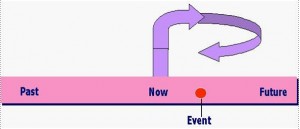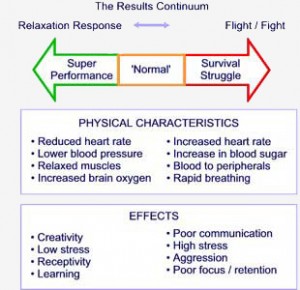One would assume that the most common questions asked of a RenEx instructor has to do with topics such as rep performance, load, fat loss, or a variety of other exercise protocol/ health related topics.
 It may come as a surprise however that THE most common question I, as an instructor, get asked has to do with the anxiety that precedes the performance of High Intensity Training.
It may come as a surprise however that THE most common question I, as an instructor, get asked has to do with the anxiety that precedes the performance of High Intensity Training.
What may also come as a surprise is that among all of the anti-paradigmatic ways that we at RenEx approach exercise in general, the thing that may differentiate us from the mainstream more than anything else is our approach to the topic of dealing with workout related anxiety.
Anxiety is an interesting topic because for the most part its manifestation is a neural and psycho-physiological response enacted through a chain of events that originated from something imagined.
While it may be true that the perceived event that the anxiety is in  response to may be based on events that actually occurred, the fact of the matter is that the anxiety itself is stimulated by something that happened in the past or hasn’t happened yet (and may never).
response to may be based on events that actually occurred, the fact of the matter is that the anxiety itself is stimulated by something that happened in the past or hasn’t happened yet (and may never).
Not unlike any other instinctual evolutionary mechanism, anxiety is an essential survival response to stress, similar in nature to the fight or flight response.
Also, similar to the fight or flight response, its rampant stimulation is more or less self created in and by our modern day world.
 Buttons that were probably only ever meant to be pushed a few times throughout a lifetime are now stuck in the “on” position constantly and all because we live in our heads.
Buttons that were probably only ever meant to be pushed a few times throughout a lifetime are now stuck in the “on” position constantly and all because we live in our heads.
Taking the preceding information into consideration, it should come as no surprise that the process of purposefully engaging in an activity (like High Intensity Training) that the body perceives as life threatening is going to be likely to create a certain degree of almost unmanageable anxiety.
What I find interesting at this juncture is the dichotomy between the commonly stated objective of strength building exercise and the traditional attitude often applied by trainers and trainees alike in fulfilling that objective.
If you were to ask most people educated in the field of exercise to state the objective of strength training you would almost unanimously hear something like this: “To apply a stress to the body in such a fashion that it stimulates the organism to respond via a process of adaptation.”
I’ll assume that everyone reading this understands the aforementioned adaptation is more muscle.
An often stated and sometimes implied corollary to the exercise process is that we must momentarily dupe or trick our body’s protective instincts into allowing us to stimulate our biology.
So why then have we always gone about this by primarily trying to find an external means to control this situation?
Notice I said primarily.
We try to manipulate external variables such as sets, reps, speed of motion, equipment, environment, nutrition and so on.
These things are most certainly required and do address the structural components of the stimulus, but for the most part they completely ignore what may be the most critical barrier that we must workaround: the fight or flight response and other psychosomatic variables like anxiety.
 Remember that these, like the reluctance of the body to build muscle, are also part of the protective mechanism that must be duped.
Remember that these, like the reluctance of the body to build muscle, are also part of the protective mechanism that must be duped.
Most don’t care to study these variables because this field often carries a “stink” of either macho posturing or overly analytic intellectual arrogance.
The former is “tougher” and less “flakey” and the latter is more scientific and prestigious.
I’m not pointing fingers as I’m as guilty as anyone.
It is my supposition however, that we tend to study the external things because they are graspable objects that fit nice and neatly into our conceptual boxes.
In other words, we can control them and we don’t like to study things we can’t control.
In so doing, we have (up until now) completely ignored the one thing that could be the rate limiting factor.
I say “could be” because one, I don’t know, and two I’d prefer not to stick my foot in my mouth.
To go deeper requires that we give up our ego and admit that we don’t understand ourselves well enough to make anything else matter.
Maybe it’s because I’m not bright enough to delve into the more mechanical issues of exercise, but duping the fight or flight response and the tertiary issues of anxiety has always been my primary area of interest.
Like I said, it doesn’t make much sense to me to spend so much time trying to stress and trick the body by assaulting it externally if you can’t get past “the anxious gatekeeper” first.
In my opinion, there is a sequence to the duping process and this sequence must be followed if a trainee is going to be able to consistently and skillfully apply the stimulus.
Skip one step in this process and stimulation becomes a hit or miss affair.
 In a few days I’d like to follow up with my experiences in trying to “dupe the gatekeeper” and touch on the way I’ve commonly seen this approached, what works and what doesn’t, and why something so stupidly simple is so profoundly important.
In a few days I’d like to follow up with my experiences in trying to “dupe the gatekeeper” and touch on the way I’ve commonly seen this approached, what works and what doesn’t, and why something so stupidly simple is so profoundly important.
I’d like to delve into the head of the trainee and maybe do a play by play analysis of a set of exercise.
Until then, please leave me your comments below as this topic of fight or flight response is a topic I believe we will all benefit from greatly and I’d love to hear your thoughts on it.
{ 30 comments… read them below or add one }
great post, was just talking about this last week with the owner of the facility I am working in.. I had mentioned that I thought the lites were to bright and maybe we could get a dimmer switch.. that it would help clients be more calm, be able to “get inside” themselves and lessen the compulsion to gab. While on that note I mentioned that I had just been reading about the fact that we have two brains.. left & right..over simplistic but I said I thought the left brain may be more prone to distraction and anxiety, it is dominant and does the “figuring” we decided to try deep breathing briefly before starting the session .. Steve Scott
Steve,
Dim lighting definitely has a cooling/calming effect
i think Al plans to go into some of these variables
Thanks Steve,
I may dive deeper into the environmental stuff in a few posts. For now what I wish to address is how the paradigm that we have set up for ourselves is what actually creates training anxiety.
As per the deep breathing; it could be helpful for some people. As I will display shortly however, it may be unnecessary as is pre workout mental prep. If the stated objectives of the workout are corrected, anxiety goes away.
Keep commenting as it will give me more and more to add to the follow up posts.
Thanks again!
Al
Fascinating subject and a VERY common issue with HIT’ers. Most, IMO, are dreading the pain that is imminent. -and many are completely obsessed with the need to demonstrate “progression” in some form or they view their efforts as ineffective. I think that to expect progression to be constant and linear is a mistake. There are simply too many variables that will determine when a significant adaptation will occur. Hence the focus should be mostly on the stimulus.
BTW, great site and great progress in the field of HIT.
I’m a devoted fan.
Mario
Dr.Leonardo,
I’m not convinved that most of the so called “progressions” aren’t digressions from what i’ve seen in the H.I.T world.
Thank you for taking the time to comment.
Joshua
Dr. Di Leonardo,
Like Josh said, I’m pretty sure what most HIT trainees consider “progression” actually winds up being a regression. The so called “progression” is an attempt to force adaptation via external means ONLY!! What I wish to relay in these post is that there are a few things that must be duped before the external things even become relevant.
So many trainees spend the entire time between their workouts thinking about what they are going to do the next workout. A skilled trainees knows how to “turn it on the dime”.
Al
What I wish to relay in these post is that there are a few things that must be duped before the external things even become relevant.
So many trainees spend the entire time between their workouts thinking about what they are going to do the next workout. A skilled trainees knows how to “turn it on the dime”.
==Scott==
I think I understand that you think there are ways of duping the body into further growth by certain means and while I don’t understand how it does seem possible.
As for the anxiety or worry, I never worry or even think about my next workout until I’m standing there before the machines ready to workout. It’s like fishing. The worst day of fishing is better than the best day at work. Even if I don’t catch anything/ make gains lifting, and I rarely do, I’m having more fun working out than most anything else I do so what’s to worry about?
Hi Joshua,
I believe that my anxiety for the work outs
wasn”t for the expected discomfort but more wether I could improve my tul or increase the weight (not necessary resistance). Since I don’t record my work outs (thanks to you and al) for several weeks I feel more relaxed going in to the work out but experience a intenser work out.
I recorded on video several work outs(an eyeopener) and see that I need to concentrate more on proper execution.I didn’t experience this however during the execution of the exercises.Not to worry about tul etc. will allow me to do that more efficiently .
Btw , ou asked me several posts ago to video my excecution on the leg press so you could judge wether my rep speed turn around etc. are as good as posibble for the used machine. Due to camera problems I couldnt record my lest leg work out , but will do so in 2 weeks Can I still link you then to my youtube channel? My other work outs can be viewed there also . The channel is called myogeen.
Thanks,
ad
Al,
The anxiety you speak of, does it go away as one progresses in a program or does it get worse?
In my experience, the more intense a set in a program gets, the more the body prevents itself from ever matching or exceeding that performance.
Thanks,
“In my experience, the more intense a set in a program gets, the more the body prevents itself from ever matching or exceeding that performance.”
Beau,
EXACTLY!!! This is the problem of which I’m speaking. There is a protective mechanism at work here that no one has addressed and the traditional progression pradigm actually makes that mechanism stronger. I feel there is a way around it and that will be the topic of an upcoming post.
To answer your first question, yes. It goes away because if you approach the potentiation of the stimulus correctly, then there never will be the trigger for the anxiety in the first place.
Thanks for reading,
Al
the more intense a set in a program gets, the more the body prevents itself from ever matching or exceeding that performance.”
==Scott==
That’s an interesting concept Al! I guess somehow the body knows it pressed a record 300 pounds for 3 reps and the next time it is tried the brain or body doesn’t want to let you do that again for some reason? Are we talking a mental mind block kind of thing or an actual physical thing?
Scott,
It is a mental block, but also a physical one. One of the things that I think we in the west need to stop doing is dividing things into the mental and the physcial. The brain is physcial matter and is what produces thoughts, those thoughts in turn have profound physiological effects. Its a feedback loop.
Fantastic post about removing constraints that then allows the sensory/motor system to engage deeper and potently. The nervous system adapts spontaneously to what is happening in the now. “Flying under the radar” indeed. Pain if not from deformation is often from a threat whether imagined or real.
Obviously a “do or die” challenge from an Arthur Jones or the Seal Training during “Hell Week” works, but up to a point. You guys are really going somewhere else.
Jim T,
Spot on!! You put it very eloquently. The traditional objectives of HIT IMO, actually make the nervous system respond to an imagined event instead of what is occuring right NOW.
I can’t tell you how many folks over the years I’ve seen go through some monumental workout and then never be ble to recreate it. There is a very good reason for that.
Regards,
Al
Al and Josh,
You are identifying an issue that is without a doubt a mental block for many HIT practitioners. Now I’m extremely curious about how you manage the problem.
—–Waiting for your next article !
I’m constantly reminding my clients that the battle is within. While progression indicates changes could be occurring, only they know if they are winning or losing the battle.
As a follow-on: For many years I’d add resistance automatically to an exercise when the client passed a certain tul. Now I’m more careful to find out more about how the client experienced the set before deciding an increase is in order.
Some might think that all this stuff is being “over-intellectualize”. After all, we’re just moving weights up and down. But that’s like saying a professional baseball pitcher is just throwing a ball, a professional golfer is just hitting a ball, etc. No one criticizes a pro for “over-intellectualizing” throwing or hitting a ball. It’s part of why they’re so good at what they do. Why should this be any different?
Right Hugh. I find it funny how “over-intellectualizing” things is often demeaned. Sure, somethings can be over thought, but we are purposefully making a study out of this in which case note taking is important. Deep thought and rumination is the only way to progress with this field of study.
I’ve complete around 12 supervised SS workouts now and for the first time, (been able to) intentionally ignore my chart. I have not asked once if I have “gone up” in weight or time, although Abby has mentioned that she is raising the weight and I know it has gone up incrementally on at least a few exercises I have purposefully ignored it.. what a luxury, and I have gotten in the best shape of my life..after over 25 years of not really enjoying training. For the first time I genuinely look forward to my session, and am getting stronger. I think I have an idea of what guys are getting at and find it Very exciting.
Thanks Steve! I’m happy that we have had the chance to ignite your joy of training.
Hi Al
Great post!!! I am looking forward to the follow up. For me, anxiety or trepidation preceeding any important event has always been linked to the fear of failure (entering a bench press competition, sparring with a high level martial artist or, in my single days, asking the most popular girl out on a date.)
When I trained using the high volume approach, no anxiety existed since I did multiple sets and at least one or two would show improvement somewhere along the way. When I trained using the Mentzer style and in my early days of Super Slow training, the anxiety was greater as the volume and frequency were so much less and I was fixated on workout to workout improvement in TUL, resistance, or both.
I still have a little bit of pre-training angst, which usually disappears as soon as the first rep of the first exercise commences. And you probably know which exercise gives me the most anxiety. So any tips to fly under the radar of this fight or flight syndrome will be most appreciated.
Ed H
Ed,
We’ll discuss this when I see you again, but it is no different than the things I’ve already been trying to teach. I’ll try to connect them for you on Thursday.
Al
Just thought I would share a couple of writings I’ve come across online. The content to me, seemed to go with the forward thinking on this website. I wasn’t quite sure where to post them.
From bodybuilding.com:
Patrok 03-15-2006, 07:55 AM
“just quoting…
There are many factors involved in making progress; adding weight to the bar is just one of them. In short, progressive overloading is overrated.
I have great admiration for the book Supertraining by Siff and Verkhoshanksy. Not only is it one of the best books ever written on strength and conditioning, but it also does an excellent job disputing some common weightlifting myths. One of my favorite parts of the book deals with progressive overloading. Basically, progressive overload refers to a need to constantly increase load in order to develop greater strength levels.
Remember the legend of Milo? He was the fella who carried around a calf everyday. As the calf grew and got heavier, Milo got stronger with each passing day carrying that sucker around. That’s progressive overloading. Sounds simple, huh? But check out this excerpt from the Supertraining book:
Closer examination of the Milo tale reveals an incomplete ending. Milo, being an enterprising strongman, obviously would have sought further increase by lifting progressively heavier bulls. If he had progressed very gradually, the implications are that he should have been lifting well over 500kg after a few years. Similarly, if you began your first bench press with 60kg at the age of 16, then increased the load by only one kilogram per week, you should be lifting 580kg at the age of 26 and 1100kg at the age of 36 years. [Note: That’s 2420 pounds!] That this will not happen is obvious. In other words, progressive overloading produces diminishing, and ultimately zero, returns (1).
In other words, that Milo tale might very well be a bunch of bull! I’m not saying that progressive overloading is useless and I don’t think Siff and Verkhoshansky were either. Instead, the concept isn’t as clear-cut and simple as it seems. Merely adding more weight to your barbell every session isn’t going to turn you into a strongman. It’s just not that simple.”
——————————————-
This one is from dcrtech.com:
“Mindbending question for experienced exercisers in a standard 1 set/10 rep scenario: “If I’m strongest at the beginning of the set, and weakest at the end of the set, shouldn’t I be lifting more weight in the beginning, and less weight at the end? … Shouldn’t the weight change with my changing level of strength Through the set?”
Ryan,
Interesting. I need to read it a little more thouroughly, but I like where it was going.
Thanks!
Al
Al,
Thanks for broaching this important topic.
Hugh accurately commented “the battle is within” which reminds me of the expression-
“Masakatsu Agatsu- True victory is Self-Mastery”
I look forward to your subsequent posts .
Thanks John. I hope all is well.
Josh,
I spend a lot of time on Dr. McGuff’s website and lately he’s been mentioning you guys quite a bit. One particular aspect he keeps referring to you is the RenEx’s “squeeze” technique.
I can’t quite seem to find a direct reference to it yet. I’ll keep looking and reading around but I was wondering if you had something handy already or maybe you could just elaborate a little on that. Whatever it is, you got Dr. McGuff throughly impressed with it and that can’t be very easy thing to do.
Thank you.
Ernesto,
This subject requires a few chapters to clarify, we have some more blogs planned too.
The best discussion is in our new technical manual to be released in July.
I will be discussing this subject on a radio show next month too.
Joshua
Sounds good. I’ll look forward to it. Appreciate sharing the info.
Just Do It , maybe we are overthinking this.
Approach the machine, set it up.
Complete each exercise by going to absolute failure.
Your done.
You have accomplished your goal.
Don’t overthink anything.
When you know you gave absolutely everything , there is no lingering problems, mental or physical.
Now if you held back some for another machine, you are doing yourself a disservice.
Give 100% and let your body fully recover… let the chips fall where they may.
Like someone above said (Al?) there are too many variables to account for everything, so give 100% of what you have available that moment, that day and you will be satisfied mentally and physically.
When I used to race long distance bike races, as long as I gave 100% I was good with my effort, I was happy because I knew I left nothing on the table.
I hope these thoughts make sense…